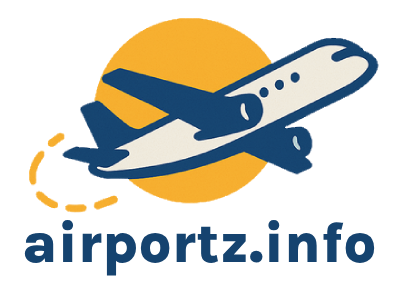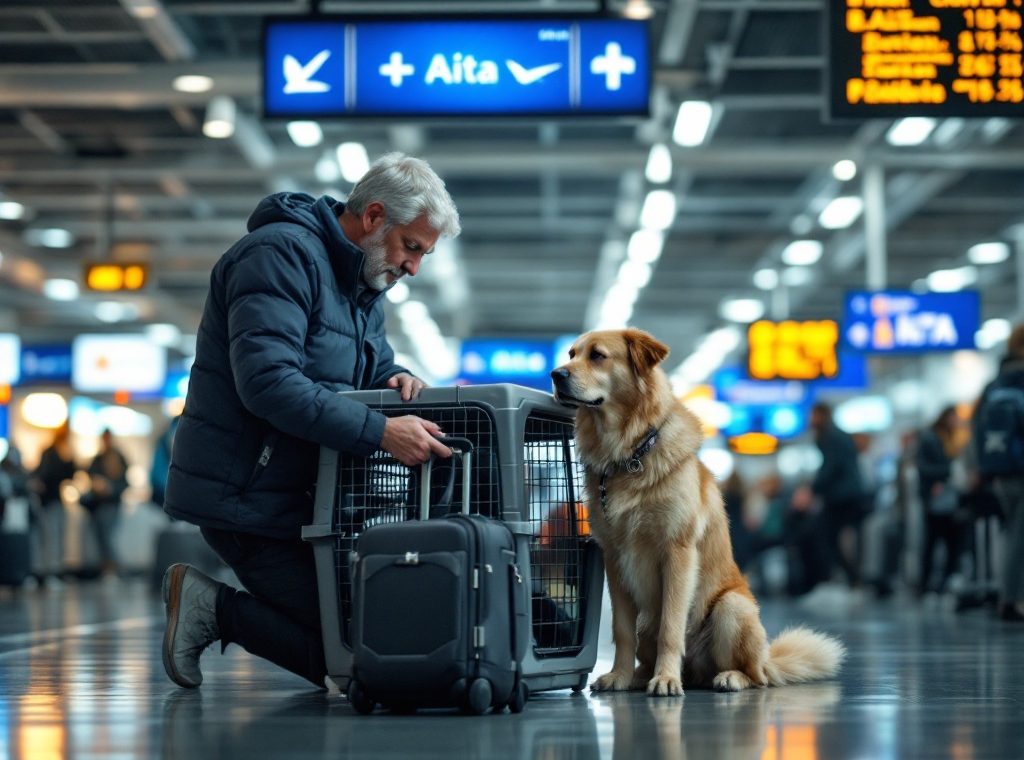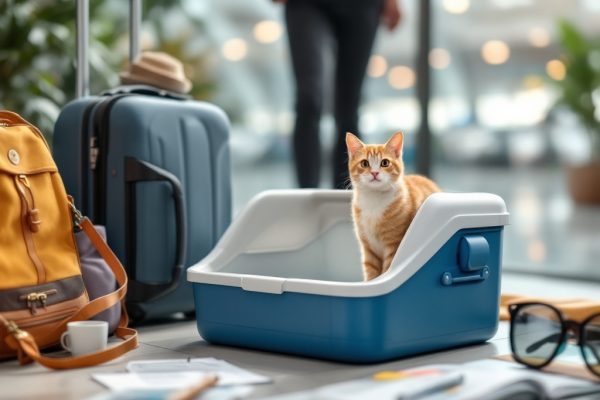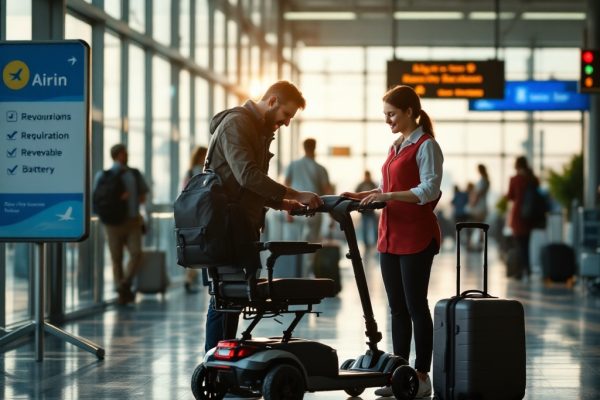Air Travel with a Large Dog: How to Make a Trip More Convenient
Planning a flight with your large dog? Safe and comfortable air travel for your furry friend requires careful preparation. This guide covers essential steps, from choosing the right airline and crate to understanding temperature restrictions (45-85°F) and managing your dog’s anxiety. Learn how to meet IATA crate standards, navigate airport procedures, and ensure a smooth journey for both of you. Discover expert tips and resources to make your next flight with your large dog a success. Read on to prepare for takeoff!
Important information
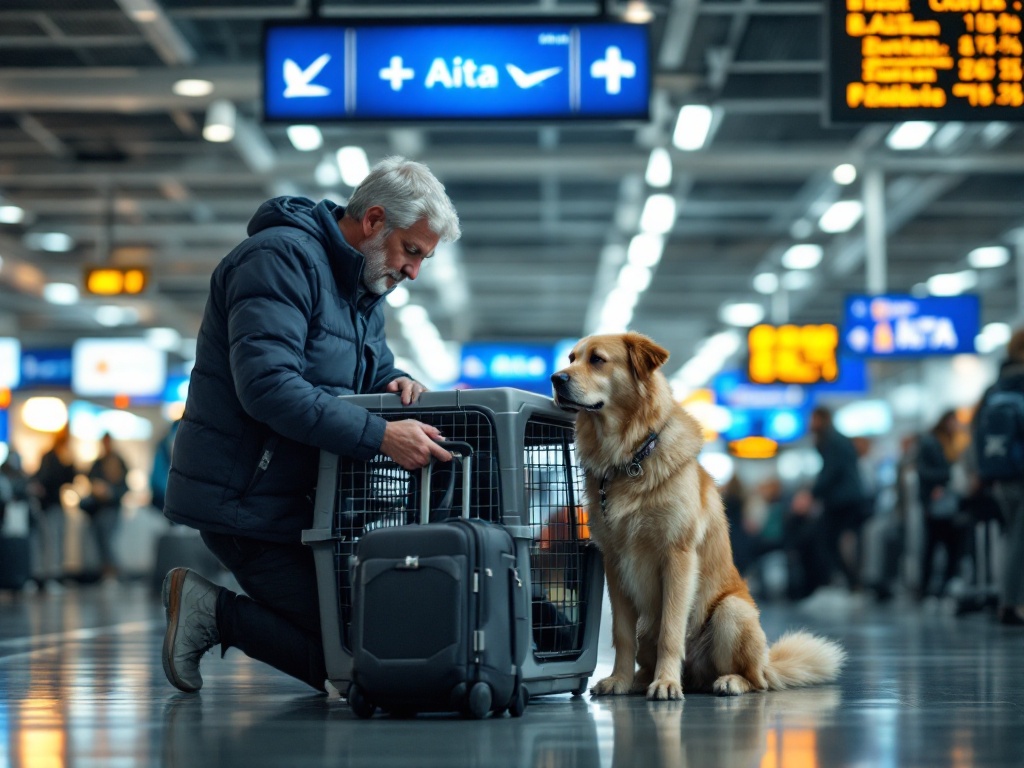
- Large dogs typically travel in the cargo hold. Book direct flights whenever possible to reduce stress and travel time.
- Use an airline-approved crate that’s large enough for your dog to stand, turn, and lie down in comfortably. Proper ventilation is key.
- Prepare a health certificate from a vet within 10 days of the flight and ensure vaccinations are up-to-date.
- Acclimate your dog to the crate before the trip using familiar items, treats, and short car rides.
- Withhold food 4-6 hours before the flight, but offer water. A tired dog travels better, so exercise before heading to the airport.
Understanding Air Travel with a Large Dog
Traveling with a large dog requires careful planning, especially regarding airline regulations. Due to cabin size restrictions, larger dogs usually travel as cargo, so direct flights are recommended to minimize your pet’s stress. Choosing the right airline is essential, as is selecting an appropriate crate that meets their requirements and ensures your dog’s comfort and safety. Addressing your dog’s potential anxiety with familiar toys or blankets and having necessary health documents are also vital for a smooth journey.
Choose a direct flight. Direct flights minimize travel time and reduce stress for your dog.
Select an appropriate airline. Research airline-specific pet policies and choose one with experience transporting large dogs.
Use an approved travel crate. Ensure the crate is airline-approved, the correct size for your dog, well-ventilated, and secure.
Address your dog’s anxiety. Include familiar toys, blankets, or clothing items in the crate to comfort your dog.
Prepare necessary health documents. Ensure you have all required health certificates and documentation for your dog’s travel.
Airline Regulations and Requirements
Flying with a large dog requires adherence to airline regulations, including obtaining a health certificate within 10 days of departure. A compliant crate, meeting IATA standards for size, ventilation, and construction materials, is essential for your dog’s safety and comfort during travel. Ensure the crate is large enough for your dog to stand, turn around, and lie down comfortably. Proper ventilation is crucial to prevent overheating, and the crate should be constructed from durable, non-toxic materials.
Temperature and Weather Restrictions
Airlines enforce temperature restrictions, generally between 45 and 85 degrees Fahrenheit, to ensure your pet’s safety and comfort during air travel. This measure protects animals from extreme temperatures.
Cabin vs Cargo: The Options for Large Dogs
Traveling with larger dogs usually requires them to travel in the cargo hold, the underbelly area of the plane also used for luggage and freight. This is due to their size. Smaller dogs can often travel in the cabin with their owners, provided they fit comfortably in carriers stowed under the seat. Airlines have strict regulations for large dogs traveling in cargo, covering crate dimensions, construction, and ventilation. For example, crates must be large enough for the dog to stand and turn around comfortably. They must also be sturdy and well-ventilated for a safe journey.
Traveling with large dogs
Large dogs typically travel in the cargo hold due to their size.
Airlines have specific regulations for crates regarding size, construction, and ventilation.
Traveling with small dogs
Small dogs can often travel in the cabin with their owners.
They must fit comfortably in carriers stowed under the seat.
Key crate requirements for large dogs:
- Enough space for the dog to stand and turn around comfortably.
- Sturdy construction for safe transport.
- Adequate ventilation.
Preparing Your Dog for Air Travel
Acclimate your large dog to its travel crate by starting with short car rides. This fosters a positive association with the crate.
Ensure your dog’s vaccinations are current. A vet check-up before your trip is recommended.
Train your dog to remain calm in bustling environments to ease airport and airplane anxieties.
A vigorous workout before the flight will encourage relaxation during travel.
Health Certificate and Vaccination Documentation
Airlines prioritize the safety and well-being of your dog during air travel. They require a health certificate from a licensed veterinarian confirming their fitness to fly. You must also provide current vaccination records, including proof of rabies vaccination. These regulations ensure the protection of all animals during air travel.
Getting Your Dog Comfortable with the Crate
Make the crate a comfortable and inviting space for your dog by adding familiar bedding, toys, and tasty treats.
Feed your dog inside the crate to create positive associations.
Start with short stays in the crate and gradually increase the duration.
Practice closing the crate door for brief periods, rewarding your dog for calm behavior.
Take short car rides with your dog in the crate to simulate travel and further acclimate them.
If your dog continues to experience anxiety, consult your veterinarian about calming aids or pheromones.
Patience and positive reinforcement are essential for successful crate training.
Managing Feeding and Hydration Before the Flight
Withhold food from large dogs four to six hours before air travel to minimize their need for bathroom breaks. Ensure they are well-hydrated beforehand, but restrict water intake right before the flight to avoid accidents.
Selecting the Right Crate for Your Large Dog
The International Air Transport Association (IATA) sets standards for pet air travel crates. These crates must allow your dog ample space to stand, turn, and lie down comfortably. Crucially, the crate needs sufficient ventilation and secure, non-collapsible latches for safety. Acclimating your dog to the crate before the flight reduces travel stress.
Compliance with Airline Regulations
Traveling with a large dog requires careful planning, especially regarding the travel crate. The crate must adhere to airline regulations, typically based on IATA Live Animal Regulations, which cover crate construction, size, ventilation, and labeling. Because airlines often have additional requirements beyond these minimum standards, contacting your chosen airline directly is essential. Confirming their specific crate requirements for large breeds will ensure a smooth and comfortable journey for your pet.
Size and Dimensions of the Crate
When choosing a crate for your dog’s travels, ensure it offers enough room for your dog to stand, turn around, and lie down comfortably. This not only prioritizes their well-being during the journey but also ensures adherence to airline regulations.
Ensuring Comfort and Proper Ventilation
A well-ventilated crate is crucial for a dog’s comfort, especially during air travel. Proper airflow ensures a more pleasant journey.
Choosing the Best Flight Options
For a smoother trip with your dog, prioritize direct flights to minimize travel time and stress. If a direct route isn’t feasible, select layovers with ample time for your pet’s bathroom breaks and exercise. Flying during off-peak periods, such as weekdays or early mornings, can also create a calmer, less crowded airport experience for both of you. Consider booking a pet relief area near your gate in advance if available. Ensure your dog’s carrier is airline-approved and provides enough space for them to stand, turn around, and lie down comfortably. Lastly, consult your veterinarian about any necessary medications or calming aids for your dog’s travel anxiety.
Direct Flights vs Layover Flights
Direct flights are often the best option for traveling with large dogs. They significantly reduce travel time and minimize anxiety by eliminating transfers and the need to move your dog between planes. This also means less handling by airport staff, which is a benefit for nervous dogs. While direct flights may cost more, the reduced stress and lower risk of complications often make them worth the investment for your pet’s well-being and your peace of mind.
Scheduling Flights During Off-Peak Times
Traveling with a large dog is often easier during off-peak flight times. Quieter, less crowded airports create a smoother, less stressful experience for your pet. The calmer atmosphere benefits your dog, and the increased availability of airline staff allows them to provide more personalized assistance. Ultimately, choosing off-peak travel makes the journey more enjoyable for both you and your furry companion.
Navigating the Airport and Security Procedures
Arrive at the airport early to ensure ample time for checking in your large dog.
Have your dog’s health certificate, vaccination records, and airline paperwork readily available to present at the check-in counter.
Arriving at the Airport in Advance
Arriving at the airport early minimizes stress for both you and your pet. This buffer allows for unexpected delays and ensures ample time for check-in and security. Your pet will also appreciate the extra time to acclimate to the new environment.
Checking In with Your Dog
Present your dog’s health certificate and vaccination records at check-in. Airline staff will review these documents.
Presenting Required Documentation
Ensure you have your pet’s health certificate and vaccination records on hand, as these are typically required by airlines for pet travel.
Ensuring Comfort and Safety During the Flight
A dog’s well-being during air travel depends significantly on the cargo hold environment. Maintaining appropriate temperature and air pressure is crucial for a safe and comfortable journey. Adequate crate ventilation is also essential.
Managing Temperature and Air Pressure in the Cargo Hold
Airlines prioritize animal well-being during transport. They carefully manage the cargo hold’s temperature and air pressure, creating a pressurized environment similar to the passenger cabin to prevent altitude sickness. Climate control maintains a comfortable temperature, typically between 10 and 21 degrees Celsius, ensuring a safe and pleasant journey for the animals.
Hydration and Feeding During the Flight
Don’t feed your dog during the flight, but make sure they stay hydrated. Offer water in a spill-proof bowl securely attached to their crate. Freezing the water beforehand helps prevent messes during loading.
Tips for Reducing Stress in Dogs During Air Travel
Before your flight, a good run and a final bathroom break will help ease your dog’s anxiety. Pack chew toys and a travel kit to keep them entertained and occupied. A familiar blanket or toy offers extra comfort. For dogs with severe anxiety, consult your vet about calming aids or techniques. Your own calm demeanor and positive reinforcement will also help soothe your furry friend.
Exercise and Bathroom Breaks Before the Flight
Exercising your dog before a flight helps reduce stress and anxiety. Bathroom breaks are also essential, especially a final one right before crating, to ensure your dog’s comfort and prevent accidents during the flight. A tired dog is a calmer traveler.
Using Chew Toys and Doggy Travel Kits
A chew toy can offer a welcome distraction for your dog during flights, providing a sense of familiarity that helps reduce stress. To further alleviate anxiety, consider a doggy travel kit containing familiar toys, blankets, and treats, along with travel essentials. These kits typically include food and water bowls, waste bags, and a first-aid kit for minor mishaps, ensuring a smoother journey for both you and your pet.
Dealing with Separation Anxiety
Acclimating your dog to their travel crate before a flight is crucial for minimizing their stress. Place familiar toys and blankets inside, along with clothing that carries your scent, to create a safe and comforting environment. Short crate sessions in the days leading up to the trip are also recommended. A calming pheromone spray or a shirt you’ve worn can also help soothe your dog during the flight.
Place familiar toys and blankets inside the crate. Add clothing that carries your scent, creating a safe and comforting environment.
Conduct short crate sessions in the days leading up to the trip.
Use a calming pheromone spray or a shirt you’ve worn to soothe your dog during the flight.
